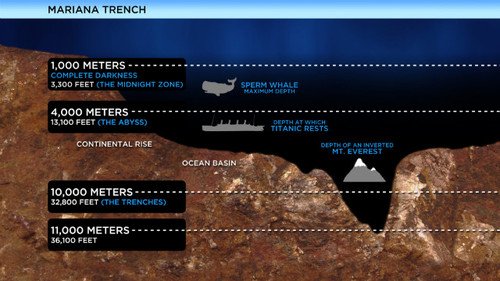A new study suggests that Mariana Trench – the deepest place in the ocean – is teeming with microscopic life.
An international team of scientists found that the very bottom of the Mariana Trench, which lies almost 7 miles down in the Pacific Ocean, had high levels of microbial activity.
The research is published in the journal Nature Geoscience.
Mariana Trench was once thought to be too hostile an environment for life to exist.
But this study adds to a growing body of evidence that a range of creatures can cope with the near-freezing temperatures, immense pressures and complete darkness.
Dr. Robert Turnewitsch, one of the authors of the paper from the Scottish Association for Marine Science, said: “The deepest parts of the deep sea are certainly not dead zones.”
In 2010, the scientists sent an unmanned submersible down into the vast underwater canyon, where it collected samples of the murky sediment that cakes the sea floor.
An analysis of the levels of oxygen in the sample revealed the presence of a large number of microbes.
Dr. Robert Turnewitsch explained: “These microbes, they respire as we do. And this oxygen consumption is an indirect measurement of the activity of the community.”
Surprisingly, these primitive, single-celled organisms were twice as active at the bottom of the trench as they were at a nearby 4 mile-deep site.
They were feasting on a plentiful supply of dead plants and creatures that had drifted down from the sea surface, the decomposing matter becoming trapped within the steep walls of the trench.
“The amount of food down there and also the relative freshness of the material is surprisingly high – it seems to be surprisingly nutritious,” said Dr. Robert Turnewitsch.

The level of material found at the bottom of the trench was so high that it suggests the Mariana Trench – which is in an area of the ocean known as the Hadal zone – could play a key part in the carbon cycle and therefore in regulating the planet’s climate.Dr. Richard Turnewitsch said: “The fact that large amounts of organic matter that contain the carbon accumulate and are focused in these trenches also means they play an important role in the removal of carbon from the ocean and the overlying atmosphere.
“The Hadal trenches may play a more important role in the global marine carbon cycle than was previously thought.”
Further insight into the Mariana Trench has recently been provided by Hollywood director James Cameron.
In 2012, James Cameron made the dive to the bottom in a one-man-submarine, becoming the first person to have visited this deep spot for 50 years.
He recently released some of the first scientific results of his dive at the 2012 American Geophysical Union Fall meeting.
Working with scientists from the Scripps Institute, the team found giant amoeba and shrimp-like creatures called amphipods.
Footage of his dive will be released as 3D National Geographic documentary.
